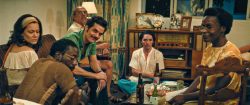Posted September 22, 2016
Raiding Raiders and the Current State of Cinema
By JBFC Education Communications Associate Paige Grand Pré
Growing up, I absolutely hated watching films with commentary. My father on the other hand, a cinephile in his own right, loved it more than anything. We’d watch rent a movie, watch it once through, and then watch it again the following day–this time with commentary. I’d grumble and whine throughout the commentary version, wondering why we had to listen to boring people talk when the movie itself was far more entertaining. More often than not, I’d wander off before the film finished. But as I aged, and began to revisit films two, three, four times, or more, I began to appreciate my father’s interest in the commentary. In re-watching a film for the third time, I was no longer concerned with hearing how a particular line was delivered or the way an actor met our gaze, but rather how a shot was constructed, or the story behind the set design. All of a sudden, watching a film with commentary from the actor or director became desirable, giving me a look at the man behind the curtain. While this form of DVD/film commentary was once revolutionary, it is now commonplace.
As technology gives us increasingly unprecedented access to media and how it is made, commentary and insight on the making of a film is now the norm, not the exception. We follow our favorite actors on set via snapchat, watch making-of featurettes on YouTube, and interact with our favorite directors through Q&As on Facebook Live; what was previously off-limits to fans is now expected as a given. It was only a matter of time, then, until someone combined all these new levels of insight into one easily-digestible form. Enter the filmumentary. Along with dozens of other media consumers, Jamie Bennings began to compile all the information, backstory, and commentary he could find into a supercut of the film, enabling you to view the film and its context in real time. Although he initially encountered pushback from studios (films are copyrighted material, after all), they have since begun to embrace the format, seeing it as a draw for fans rather than a drain on revenue.
One filmumentary in particular, Raiding the Lost Ark (coyly named for the Indiana Jones film on which it is based), has provided our staff—myself included—with hours of entertainment in the run-up to our screening of Raiders of the Lost Ark for Art House Theater day on Saturday, September 24th. Coming back to a movie I so thoroughly enjoyed as a child, it is now fascinating as an adult to learn about the immense amount of work that went into making the film happen. Every scene, every line, is dissected at a level that was previously unfathomable, giving me an immense amount of respect for just how much it takes to get even a single shot. Raiding the Lost Ark is valuable not only for helping us understand what was shot in a studio versus on location, or how they were able to make tarantulas angry enough to scamper across Alfred Molina’s back while shooting (!!!), but also because it engages us as lovers of cinema. Part of what I enjoy most about working at the JBFC is the fact that the theater’s programming revolves both around seeing films on the big screen, and why we as individuals love the cinematic experience: we can never get enough of the films we love. Our programming on Art House Theater Day, our film appreciation and analysis courses, and our Family Saturdays @ The Lab all pay testament to this passion for embracing the full range of cinematic experience, highlighting why it matters to see films on the big screen and collectively experience them as part of an audience. We invite you to join us for Art House Theater Day on 9/24 and learn more about how the JBFC caters to lovers of film—whether you’re seeing a movie for the first or fifth time.



